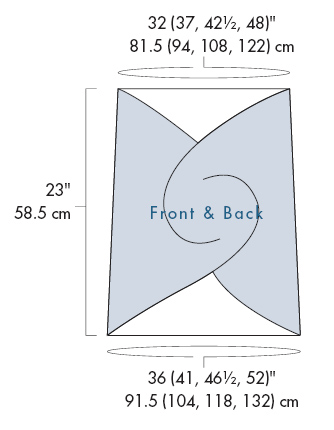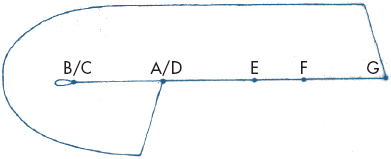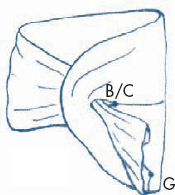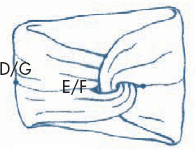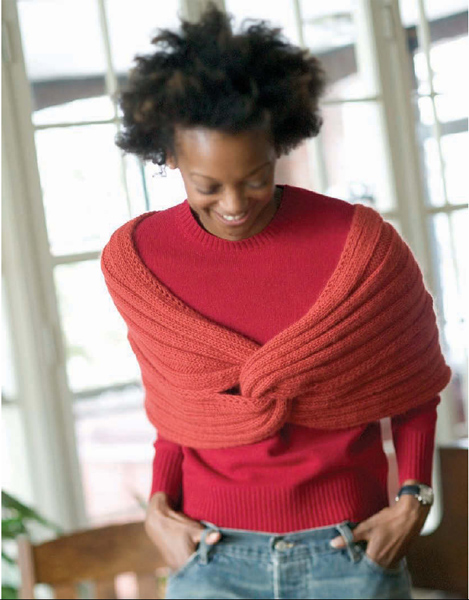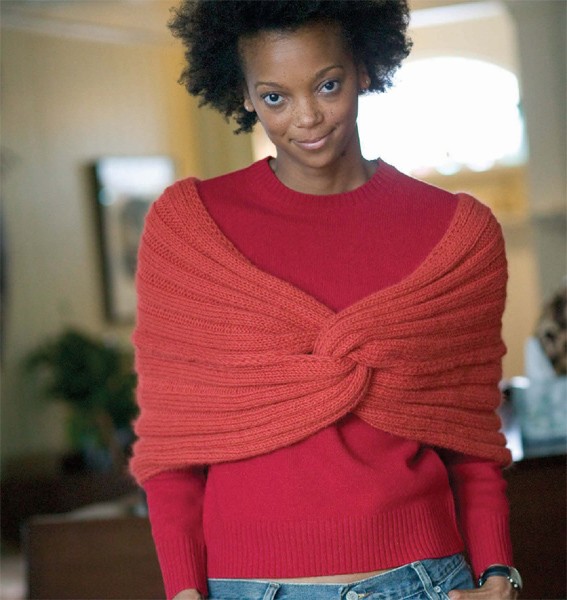
Norah Gaughan is a master at coming up with unusual construction techniques for her knitted garments. She’s taken the idea for this crisscross shoulder-hugging capelet from pictures of glamorous wraps worn by 1940s movie stars and has given it the look of a current runway piece. The wrap is surprisingly simple to execute—knit a simple rectangle shaped with gently sloped short ends. Then twist the rectangle around itself to form the complicated-looking knot at the center front. The overall effect is even more impressive if, like Norah, you use a luscious angora-wool yarn and add an oversized rib pattern.
36 (41, 46½, 52)" (91.5 [104, 118, 132] cm) circumference at lower edge, 32 (37, 42½, 48)" (81.5 [94, 108, 122] cm) circumference at neck, and 23" (58.5 cm) long. Wrap shown measures 41" (104 cm) at lower edge.
About 738 (738, 861, 984) yd (675 [675, 787, 900] m) of worsted-weight (Medium #4) yarn.
We used: Classic Elite Lush (50% angora, 50% wool; 123 yd [112 m]/50 g): #4468 madder (tomato red), 6 (6, 7, 8) skeins.
Size 8 (5 mm): straight. Adjust needle size if necessary to obtain the correct gauge.
Tapestry needle; removable stitch markers or safety pins; small hanging tags (optional).
16 sts and 21 rows = 4" (10 cm) in rib st.
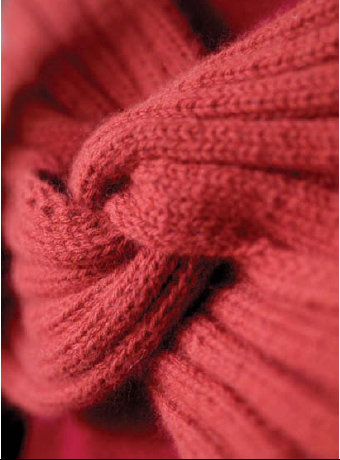
Sl 2 kwise: Sl 2 sts individually as if to knit with yarn in back.
Sl 2 pwise: Sl 2 sts individually as if to purl with yarn in front.
CO 6 sts.
Row 1: (WS) Sl 2 kwise (see Stitch Guide), [p1, k1] 2 times.
Row 2: Using the cable method (see Glossary, page 146), CO 8 sts at beg of row—14 sts. Work as foll: P4, k4, [p1, k1] 2 times, p2—14 sts.
Row 3: Sl 2 pwise (see Stitch Guide), [p1, k1] 2 times, p4, k4.
Row 4: Use the cable method to CO 8 sts—22 sts. Work as foll: [P4, k4] 2 times, [p1, k1] 2 times, p2.
Row 5: Sl 2 pwise, [p1, k1] 2 times, [p4, k4] 2 times.
Row 6: Use the cable method to CO 8 sts—30 sts. Work as foll: [P4, k4] 3 times, [p1, k1] 2 times, p2.
Row 7: Sl 2 pwise, [p1, k1] 2 times, [p4, k4] 3 times.
Row 8: Use the cable method to CO 8 sts—38 sts. Work as foll: [P4, k4] 4 times, [p1, k1] 2 times, p2.
Row 9: Sl 2 pwise, [p1, k1] 2 times, [p4, k4] 4 times.
Row 10: Use the cable method to CO 10 sts—48 sts. Work as foll: P2, [k1, p1] 2 times, k4, [p4, k4] 4 times, [p1, k1] 2 times, p2—piece should measure about 2" (5 cm) from CO along selvedge at end of RS rows (hereafter referred to as the long edge).
Row 11: Sl 2 pwise, [p1, k1] 2 times, [p4, k4] 4 times, p4, [k1, p1] 2 times, k2.
Row 12: Sl 2 kwise, [k1, p1] 2 times, k4, [p4, k4] 4 times, [p1, k1] 2 times, p2.
Rep Rows 11 and 12 until there are 490 (546, 602, 658) rows from CO (245 [273, 301, 329] slipped selvedge sts) along the long edge—piece should measure about 93¼ (104, 114½, 125¼)" (237 [264, 291, 318] cm) from CO along long edge. Work Row 11 once more to end with a WS row. Next row: (RS) BO 10 sts, work in patt to end—38 sts rem. Cont in patt, BO 8 sts at beg of next 4 RS rows, ending with a RS row—6 sts rem; 500 (556, 612, 668) rows completed; piece should measure about 95¼ (106, 116½, 127¼)" (242 [269, 296, 323] cm) from CO along long edge. BO rem 6 sts.
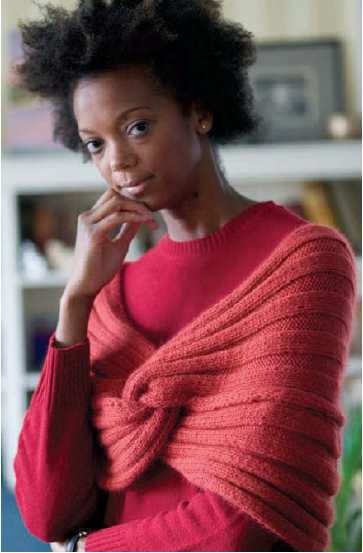
Use the principle of origami—folded paper—to get ideas for unusual construction techniques.
With removable markers or safety pins, mark points A, B, C, D, E, F, and G as shown on page 101. You may find it helpful to use hanging tags to label each point with its letter, and to mark the RS of the fabric. Beg of wrap is point A. Count 90 (102, 114, 126) rows from beg along long edge and mark point B. Count 40 rows from point B and mark point C. Count 120 (136, 152, 168) rows from point C and mark point D (center back). Count 120 (136, 152, 168) rows from point D and mark point E. Count 40 rows from point E and mark point F. End point is G; 90 (102, 114, 126) rows rem between F and G (Figure 1). Note: Seams are sewn from the WS to produce a decorative welt on the RS. Work 2 sts in from the edge and follow the slipped selvedge sts. If you sew selvedge to selvedge, you will join 2 main pattern rows for every st sewn along the slipped selvedge. If any two sections to be joined are of unequal length, ease the pieces to fit by skipping sts in the edge of the longer section at regular intervals. With yarn threaded on a tapestry needle and working from the WS, match point B to C, and point A to D, and sew the seam from B/C to A/D, easing in fullness. The 40 rows between B and C form an open loop (Figure 2). Being careful not to twist the section from D to G, poke point G from the bottom up through the open loop between B and C (Figure 3). Pull the end through so you can match points E and F to create a second loop. Match endpoint G to point D at center back, and sew the seam from E/F to D/G (Figure 4). Sew BO edge to CO edge at center back with RS facing so 2-st welt for seam allowance is on WS of fabric and will not show on the public side of the back. Weave in loose ends. Block lightly, if desired, taking care not to flatten the ribs. Wear with slightly narrower opening and center back seam at top edge.
